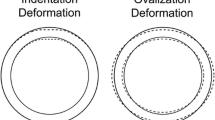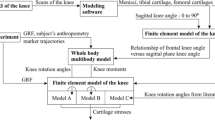Abstract
We have developed a method for static testing of the human tibia in bending in the living subject, and fabricated a prototype device for carrying it out. Model testing indicates that the device and model system are inherently accurate and reliable. However, the biological system is more complex, and while more than 200 tests have been conducted with perfect safety, the variability of replicate tests suggests that the method does not yet have general clinical utility. In some subjects, that variance is relatively small, possibly because they are more relaxed and perhaps also for anatomical reasons. In two subjects, postmortem tests corresponded very well with antemortem tests on the tibiometer. We conclude that with further refinements the method may have clinical potential, if only in carefully selected subjects.
Similar content being viewed by others
References
Granik, G. and I.D. Stein. Bone testing in the living human subject. Proceedings of the 25th Annual Conference on Engineering in Medicine and Biology 14:202, 1972.
Hight, T.K., R.L. Piziali, and D.A. Nagel. Natural frequency analysis of a human tibia.J. Biomech. 13:139–147, 1980.
Stein, I.D. and G. Granik. The tibiometer. A device for bone testing in the living person. Design and initial calibration. Proceedings of the 26th Annual Conference on Engineering in Medicine and Biology 15:256, 1973.
Stein, I.D. and G. Granik. The tibiometer. First clinical trials of anin vivo bone testing device. Proceedings of the 28th Annual Conference on Engineering in Medicine and Biology 17:174, 1975.
Stein, I.D. and G. Granik. Rib structure and bending strength: An autopsy study.Calcif. Tissue Res. 20:61–73, 1976.
Stein, I.D. and G. Granik. The tibiometer. Postmortem findings in patients tested on this device during life. Proceedings of the 29th Annual Conference on Engineering in Medicine and Biology 18:104, 1976.
Stein, I.D. and G. Granik. The tibiometer. Test reproducibility in an improved model. Proceedings of the 31st Annual Conference on Engineering in Medicine and Biology. 20:247, 1978.
Stein, I.D. and G. Granik. The human tibia. A simplified method of radiographic analysis of its cross section, with anthropometric correlations.Ann. Biomed. Eng. 7:103, 1979.
Stein, I.D. and G. Granik. Human vertebral bone: Relation of strength, porosity and mineralization to fluoride content.Calcif. Tissue Int. 32:189–194, 1980.
Stein, I.D. and G. Granik. Tibiometry. InOrthopedic Mechanics, Procedures and Devices, edited by D.N. Ghista, London: Academic Press, 1981, pp. 1–28.
Yamada, H. and F.G. Evans.The Strength of Biological Materials. Baltimore: Williams and Wilkins, 1970, pp. 1–80.
Author information
Authors and Affiliations
Additional information
Supported by the Research Service of the Veterans Administration
Rights and permissions
About this article
Cite this article
Stein, I.D., Granik, G. The human tibia: Static testing in bending by anin vivo method. Annals of Biomedical Engineering 10, 281–294 (1982). https://doi.org/10.1007/BF02367309
Issue Date:
DOI: https://doi.org/10.1007/BF02367309




